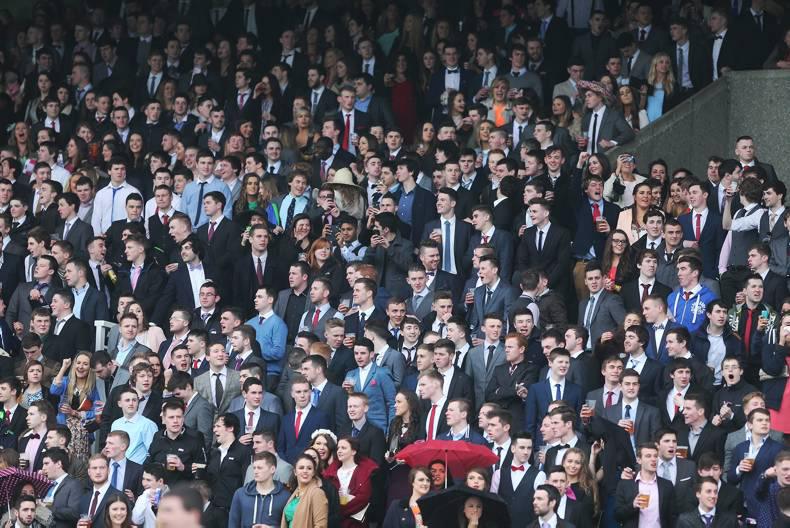2007
In the final Darley Flying Start presentation, Cathal Beale from Wexford looks at the state of Irish racing, the issues that need to be addressed and possible areas for improvements
IRELAND has many inherent advantages in the world of thoroughbred horse racing and breeding due to its natural environment, its human skills base, unique history and tradition of working with horses.’’ (Denis Brosnan, Horse Racing Ireland, Strategic Plan 2003-2007)
Beginning in this positive light the Irish racing industry is in a better position now than it has ever been. Attendance figures have risen steadily over the past five years to a record 1.45 million in 2006.
Off-course betting has more than doubled in this period, to over €3 billion last year. On-course betting has also risen steadily. Prize-money levels in Ireland are excellent, with a minimum value of €8,500 for all races run under rules and a total prize fund of €55 million.
The fixture list continues to grow and will do so for the foreseeable future, especially with the addition of the new all-weather track at Dundalk. Furthermore, Irish racehorses continue to perform at the highest level at home and abroad.
In 2006, Irish-trained horses won seven Group 1 races in Britain, four in France and nine of the 12 Group 1s staged in Ireland. Ireland is the third largest foal producing country in the world, with over 12,000 born last year. This accounts for more than Britain and France combined. This massive production, however, creates serious problems.
Overproduction
In 2002 there were 10,000 foals born in Ireland. There are, however, more non-premier horses that need to find homes, either in Ireland or abroad. Irish Thoroughbred Marketing does a wonderful job in creating and maintaining excellent client relations with overseas buyers through their Inward Buyers Programme and many other initiatives. However, if the Irish breed continues to be diluted through overproduction these relationships will prove more and more difficult to maintain.
The sales companies have added much more opportunities to sell in recent years. Goffs have recently announced a further two breeze-up sales that will be held at Dundalk for next season in January and June. The top and middle end of the market continues to be very strong, with a top price of €2.4 million being achieved recently at Goffs and where 66 individuals were sold for more than €200,000.
It is at the bottom end of the business that vendors are struggling to even cover their costs. With so many horses available to buyers at this level at the moment, this is inevitable. This could well lead to a reduction in the number of foals born in the coming years. Goffs chief executive, Henry Beeby echoed these sentiments: ‘‘If breeders pay €10,000 for a horse and make €2,000 at the sales the market forces will ensure production levels come down.’’
I agree with Mr Beeby’s assessment. However, perhaps further proposals could be introduced. I would advocate an incentive scheme for breeders at this level of the market. If there was a one-off fee of €1,000, for example, on offer to breeders of registered broodmares and if they hand over their passports and offer the mares to say the sporthorse industry, there could be a significant reduction in the lower end of the market. This would be a long term investment to aid the overproduction of horses, the dilution of the Irish breed and the issue of too many horses in training in Ireland.
The problem of over production in Ireland directly filters into the biggest difficulty trainers and owners in Ireland face today, namely balloting. In 2006 over 5,000 horses were balloted out of flat races in Ireland, with over 4,000 of these coming in handicap races. The numbers are much higher in the National Hunt sector. Again the problem does not affect the top end performers but is a major headache at the bottom rung of the ladder.
Horse Racing Ireland has recently published a list of measures to tackle this issue. Their strategy includes increasing the fixture list by 18 next year with the aid of Dundalk, while maintaining the minimum value of €8,500 per race. There will be an increase of 3lb in the minimum qualifying ratings for all handicap races next year, which will remove the lowest rated horses from the system.
Upon announcement of these reforms, Brian Kavanagh, chief executive of HRI stated that: ‘‘Irish racing must create a balance between the demand for racing opportunities and the need to develop an industry based on quality, merit and competitive prize money levels.’’ These measures will certainly bring about improvements in the system.
Other measures which could bring about further improvements would be the addition of another all-weather racecourse in the south of the country. In order to cater for these additions to the fixture list, and in order to maintain the high level of prize-money, the huge premier handicap pots could be more evenly distributed downwards to ensure trainers and owners of horses at a lower level can get a run into their horses.
In the National Hunt sector, where balloting is an even larger problem, the addition of all-weather races will obviously not ease the burden. I believe that schooling races are an excellent innovation. Fairyhouse are currently developing a new schooling track inside the main course to meet this need.
This provides another additional income to racecourses as well as giving owners an opportunity to see their horses in competitive action. According to racecourse manager Caroline Gray, this project will be completed by August 2008.
These schooling races could be incorporated into the system as a stepping stone. For example, if a horse wins one of these races perhaps they could be granted an automatic run under Rules. The same can be said of the point-to-point scene which has been a magnificent breeding ground for top-class jumpers over the years in Ireland.
If a horse were to win a point-to-point, or even be placed in the first three, perhaps they could be granted a straight entry to a maiden hurdle. In the reverse, if a horse is removed from the system under Rules they can always revert to point-to-pointing. The continued development of schooling tracks and point-to-pointing could have a large bearing on the balloting problem.
Improvements
The festival fixtures such as Galway, Listowel, Punchestown, Leopardstown, Fairyhouse and the Curragh continue to shatter records and have embraced the modern Irish audience, offering not just competitive racing but also best dressed lady contests, race card competitions and countless other incentives.
The facilities are also receiving a major overhaul with the opening of Galway’s new Killanin Stand, the proposed The Curragh and Leopardstown redevelopments and of course, the opening of the modern facility at Dundalk. The major issue for the growth of attendances, and as a result the growth of the racing product, lies with some of the smaller provincial tracks. This is not something that can be solved overnight but needs serious consideration.
The most high-profile recent analysis of racecourses in Ireland and the UK has been David Ashforth’s racecourse tour in the Racing Post. His findings have been critical of a number of racecourses in Ireland, especially in relation to basic infrastructure, restaurants, toilets and stable staff facilities.
‘‘There needs to be a change in attitude and policy. All racecourses should acknowledge their responsibility for providing decent, modern facilities; Horse Racing Ireland should make funding for new stables conditional on such provision - and stable staff should demand it,’’ according to Ashforth. There is no doubt that in terms of facilities, improvements need to be made.
Horse Racing Ireland has recently made provision for future funding in this regard. Jason Morris, director of racing at HRI, fully understands the need for improvement. ‘‘A New Racecourse Improvements Scheme under which racecourses will receive 75% grant aid towards approved projects with stable yards and stable staff facilities one of the areas that qualify for assistance and indeed which we are prioritising, with the tracks following significant progress at some courses in recent years.
“This new scheme covers 16 of the courses (basically those below the top level). All other tracks can apply for 55% grant aid towards capital development projects which could include stable yard improvements.’’ This scheme appears to signal a significant drive from HRI to address this problem.
Racecourses have an extremely difficult job keeping in business as it is, with only a certain amount of fixtures during the season providing the vast majority of their annual income. Therefore, it is extremely difficult for them to provide for these types of improvements.
In the case of Fairyhouse, a premier track entitled to 55% aid, Caroline Gray states that ‘‘even the 45% balance is difficult to find when there is no direct payback.’’ Fairyhouse recognise the need for these developments and a new €3 million upgrade is in the pipeline, with facilities and access top of the agenda. For the 19 other non-premier racecourses this new incentive provides the opportunity to make these improvements at a quarter of the price. For the long term viability of the smaller tracks in Ireland this is vital.
These potential improvements to facilities at smaller racetracks would certainly boost attendance figures. Other smaller improvements that could be implemented, might include an attempt to market the racecourses as entertainment venues, especially if the improvement in facilities can be put into practice.
At Fairyhouse a marketing initiative has begun to meet this end. They have played host to auctions, product launches, concerts, conferences, seminars and Christmas parties. These additional uses of racecourse facilities could potentially bring about a significant income to any track.
Other small improvements could be implemented including an education programme for new racegoers. There is a lot of information to digest when visiting a racecourse for the first time. A dedicated stall set up near the entrance to racecourses, especially at the premier meetings, specifically designed to deal with customer queries would be a positive step. New racegoers would surely feel more welcome and would be more likely to become involved with the sport, and ultimately come racing again, if they are helped through the teething phase.
Another suggestion would be to reward the regular racegoers with a reimbursement scheme. If someone could produce say, 15 ticket stubs from different race meetings with a stamp issued at the turnstile, they could then be granted a free ticket.
Conclusion
I have tried to emphasise the wonderful position that the Irish racing industry is in at the moment and to assess how this position can be maintained and improved in future. It is not difficult to recognise the areas of the industry in Ireland which need attention, such as overproduction, balloting and racecourse facilities. It is much more toilsome to consider the possible changes that can be made and more difficult again to successfully put those ideas in place. The many strategies and ideas already being put into place will address these problems over the coming years.


 This is a subscriber-only article
This is a subscriber-only article
 It looks like you're browsing in private mode
It looks like you're browsing in private mode










SHARING OPTIONS: